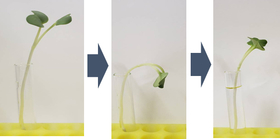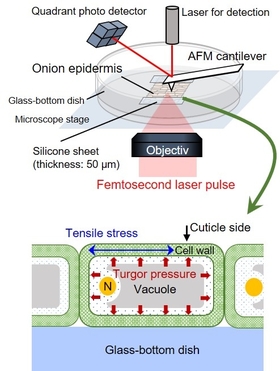Materials Science 2022/08/03
Researchers at Nara Institute of Science and Technology refine the equations for mechanical stiffness to apply to plant cell walls based on elastic shell theory and verified using finite element simulations, which may lead to a better understanding of how plants resist stress
Scientists from Nara Institute of Science and Technology (NAIST) have used elastic shell theory to describe how the stiffness of plant cell walls depends on their elasticity and internal turgor pressure. By utilizing atomic force microscopy (AFM) combined with finite element computer simulations, they were able to show that cell stiffness is very sensitive to internal turgor pressure.
Many people will have fond memories from their school days looking at onion peels under a microscope. While the individual cells might have seemed then like simple rectangles, the stability of plant cells reflects complex combinations of forces. In addition to the cell membrane which is similar in animals, plant cells also have a rigid cell wall that provides structural integrity. Turgor, meaning the normal rigidity of cells due to the pressure from its contents, is also a critical factor in maintaining balance with the environment. Too little pressure can cause the cell to shrink. Cells can regulate their turgor pressure osmotic flows that tend to balance the salt concentrations between the interior and the outside of the wall. However, the resulting mechanical properties of plant cells remain nebulous. For example, using AFM alone to determine the stiffness from cell wall deformation makes it difficult to separate the contributions from the tension of the cell wall, cell geometry and turgor pressure.
Now, a team of researchers led by NAIST has used finite element method (FEM) simulations to verify a new formula based on elastic shell theory. This allowed them to interpret the apparent stiffness observed using AFM. The team studied onion epidermal cells, which are a model system for understanding the physical properties of plant cells. "Looking at the force versus indentation data suggested that the standard equations were not sufficient for interpreting the apparent stiffness of plant cells," senior author Yoichiroh Hosokawa says.
Based on the FEM simulations, the elastic shell theory equation was shown to be better at describing the AFM response of the onion cells, compared with the conventional model used for objects without internal turgor pressure. Moreover, their findings suggest that tension caused by turgor pressure regulates cell stiffness, which can be modified by slight changes, on the order of 0.1 megapascals. "Our theoretical analysis paves the way for a more complete understanding of the forces inherent in a plant cell," Hosokawa says.
The work helps generalize our understanding of stiffness for living systems. This knowledge can be applied to help ensure that plants maintain their structure even under stressful situations, such as during periods of water deprivation.
###
Resource
- Title: Elastic shell theory for plant cell wall stiffness reveals contributions of cell wall elasticity and turgor pressure in AFM measurement
- Authors: Satoru Tsugawa, Yuki Yamasaki, Shota Horiguchi, Tianhao Zhang, Takara Muto, Yosuke Nakaso, Kenshiro Ito, Ryu Takebayashi, Kazunori Okano, Eri Akita, Ryohei Yasukuni, Taku Demura, Tetsuro Mimura, Ken'ichi Kawaguchi & Yoichiroh Hosokawa
- Journal: Scientific Reports
- DOI: 10.1038/s41598-022-16880-2
- Information about the Bio-Process Engineering Laboratory can be found at the following
website: https://mswebs.naist.jp/english/courses/list/labo_11.html






